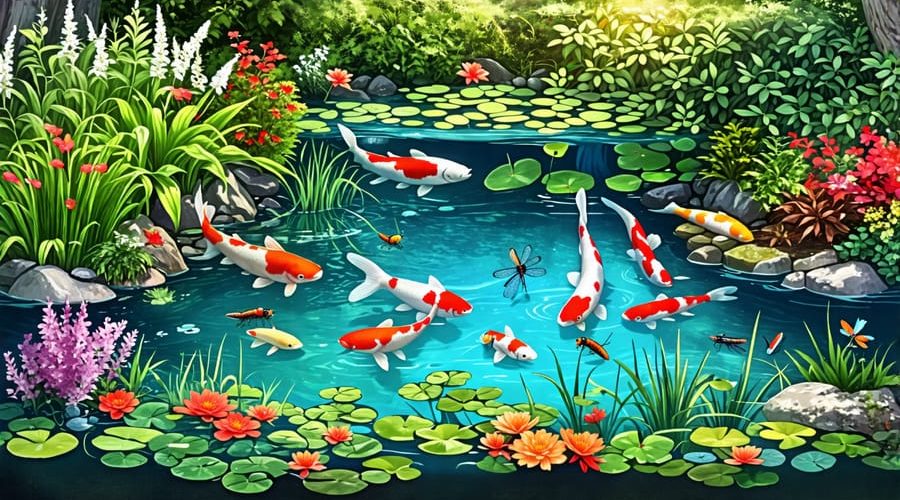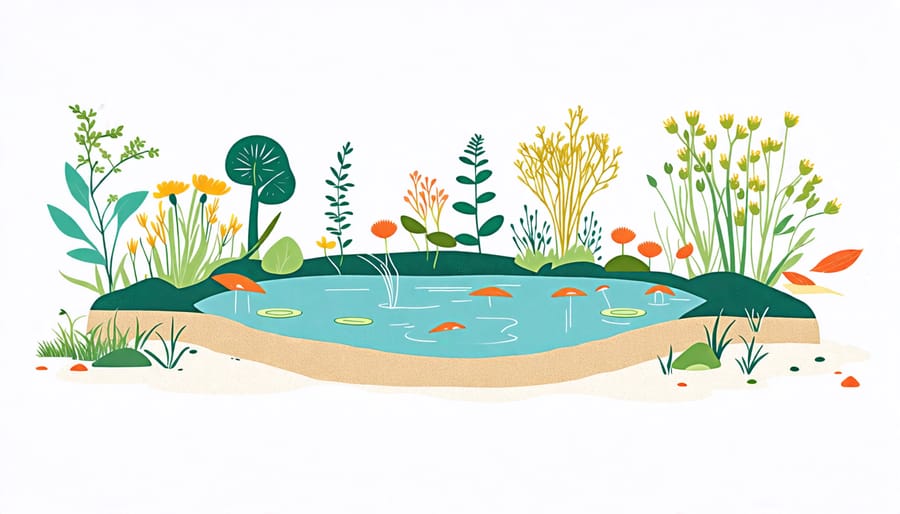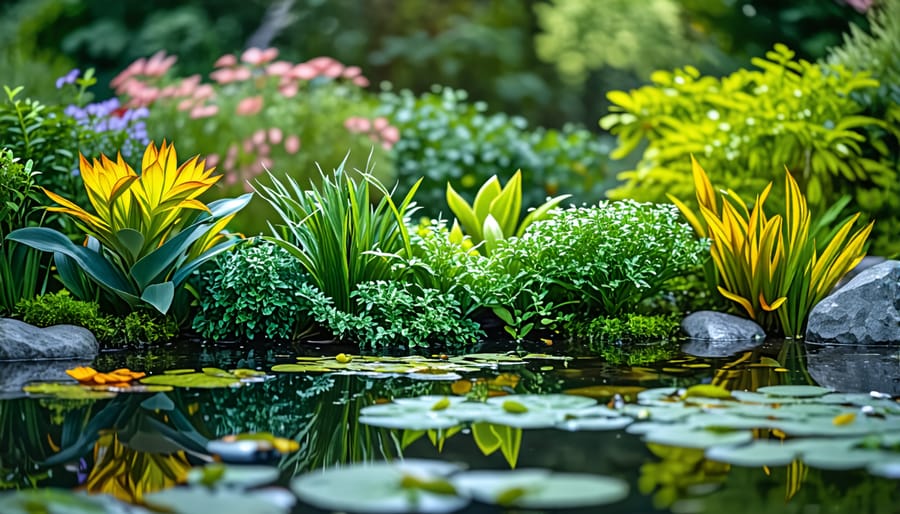
7 Secrets to Creating a Thriving Pond Ecosystem in Your Backyard
Uncover the hidden world thriving beneath the surface of your backyard pond. Dive into the delicate dance of microbes, plants, insects, amphibians and fish that create a self-sustaining ecosystem in perfect balance. Discover how each element, from algae to dragonfly nymphs, plays a crucial role in maintaining crystal clear water and supporting diverse aquatic life. Learn the science behind nature’s ingenious design and how you can harness ecological principles to create your own slice of pond paradise. Whether you’re a curious naturalist or aspiring water gardener, join us on an immersive journey into the wondrous realm of pond ecology.
Understanding the Pond Ecosystem

The Water Environment
The water environment in a pond plays a critical role in its overall health and ecological balance. The source of the pond’s water, whether it’s from rainfall, groundwater, or a nearby stream, can influence its chemistry and nutrient levels. Depth is another important factor, as shallow ponds may experience more temperature fluctuations and be prone to algae growth, while deeper ponds have cooler, more stable conditions.
Water temperature affects the metabolism and behavior of aquatic organisms, with warmer temperatures generally leading to faster growth rates. Oxygen levels are vital for fish and other aquatic life, and can be impacted by factors like water movement, surface agitation, and the presence of oxygen-producing plants.
The pH of the water influences its suitability for different species, with most pond life thriving in a neutral to slightly alkaline range. Regular monitoring and management of these water quality parameters is essential for maintaining a thriving pond ecosystem.
Pond Inhabitants
Ponds are teeming with life, from the tiniest microorganisms to larger creatures like fish and amphibians. Aquatic plants form the foundation of the pond ecosystem, providing oxygen, shelter, and food for other inhabitants. Submerged plants like pondweed and hornwort oxygenate the water, while floating plants such as water lilies and lotuses add beauty and shade. Along the edges, marginal plants like cattails and rushes stabilize the banks and filter the water.
Fish are often the star attractions in backyard ponds, with popular choices including colorful koi, hardy goldfish, and mosquito-eating minnows. Beneath the surface, a host of beneficial bacteria, algae, and zooplankton work to break down waste and maintain water quality. Insects like dragonflies, damselflies, and water striders skim along the surface, while aquatic larvae develop underwater. Frogs, toads, and newts also call the pond home, helping to keep insect populations in check while adding their unique croaks and chirps to the pond’s symphony.
Establishing a Balanced Pond
Choosing the Right Plants
Plants play a vital role in pond ecology by oxygenating the water, filtering out impurities, and providing habitat for various aquatic creatures. Submerged plants like hornwort, anacharis, and cabomba release oxygen through photosynthesis, helping to maintain healthy dissolved oxygen levels. Floating plants such as water lettuce and water hyacinth absorb excess nutrients, preventing algae overgrowth. Marginal plants like cattails, rushes, and pickerelweed filter the water and stabilize the shoreline, while offering hiding spots for fish, amphibians, and insects. When choosing plants for your pond, consider native species that are well-suited to your climate and won’t become invasive. Aim for a diverse mix of submerged, floating, and marginal plants to create a balanced ecosystem. Vallisneria, sagittaria, and ludwigia are excellent oxygenators, while water lilies and lotus add beauty and shade. Experiment with different combinations to find what works best for your pond’s unique conditions.

Stocking Fish and Other Pond Life
When stocking your pond, consider species like koi, goldfish, or native fish that thrive in your climate. Introduce fish gradually to avoid overwhelming the ecosystem. Maintain a balanced population to prevent overcrowding and ensure adequate resources for all inhabitants.
Beyond fish, populate your pond with beneficial organisms like snails, freshwater clams, and aquatic insects. These creatures help control algae, break down debris, and provide a natural food source for fish. Aquatic plants also play a vital role in maintaining water quality and offering shelter for pond life.
Monitor your pond regularly and remove excess vegetation or debris to keep the ecosystem in check. By carefully selecting fish species and supporting a diverse array of pond life, you’ll create a harmonious and self-sustaining environment that brings your water garden to life.
Maintaining Water Quality
Maintaining good water quality is essential for a healthy pond ecosystem. Crystal clear water not only looks beautiful but also supports thriving plants and fish. To achieve optimal water quality, consider installing a filtration system to remove debris and harmful compounds. Proper aeration, through fountains or air pumps, helps maintain oxygen levels and prevents stagnation. Regularly perform partial water changes, replacing about 10-20% of the pond water every few weeks. This helps dilute buildup of nutrients and waste products. Be mindful of overfeeding fish and limit fertilizers around the pond to prevent excess algae growth. By maintaining water quality through these proactive measures, you’ll create a balanced and beautiful pond environment that you can enjoy for years to come.
Common Pond Problems and Solutions

Algae Overgrowth
Algae overgrowth, also known as algal blooms, can quickly turn a beautiful pond into an unsightly green mess. The main culprits behind this issue are excess nutrients, particularly nitrogen and phosphorus, which can come from fish waste, uneaten food, and runoff from fertilized lawns or gardens. To combat algae overgrowth, start by reducing the nutrient load in your pond. Feed fish only what they can consume in a few minutes, and avoid overfeeding. Consider adding more plants to your pond, as they compete with algae for nutrients. Floating plants like water lettuce and water hyacinth are particularly effective at shading the water and limiting algae growth. Regular water changes and the use of a quality filter system can also help maintain a balanced ecosystem and prevent algal blooms from taking over your pond paradise.
Fish Die-Offs
Fish die-offs can be alarming, but understanding the causes can help prevent them. Oxygen depletion is a common culprit, especially in summer when warm water holds less dissolved oxygen. Overstocking fish, excess waste, and decaying organic matter like leaves can also deplete oxygen levels. Toxic compounds like ammonia can build up if a filter malfunctions or beneficial bacteria populations drop. To prevent die-offs, avoid overfeeding and overstocking, maintain good filtration, remove debris regularly, and consider adding an aerator. Keep an eye out for signs of stress like gasping at the surface. Partial water changes can help in a crisis. With proactive care and monitoring, you can keep your fish healthy and thriving as a vibrant part of your pond’s ecosystem.
Invasive Species
Invasive species can quickly take over your pond, crowding out beneficial plants and harming wildlife. Common invaders include water hyacinth, parrot feather, and purple loosestrife. These aggressive plants reproduce rapidly, forming dense mats that block sunlight and deplete oxygen. To combat them, manually remove as much as possible, being careful to extract roots. For stubborn infestations, consider safe herbicides designed for aquatic use.
Invasive fish like carp and goldfish can also disrupt the delicate balance of your pond. They stir up sediment, uproot plants, and produce excessive waste. Humanely remove these fish using nets or traps, and relocate them to a contained water feature or donate them to a local aquarium society. Preventing unauthorized fish dumping is key – educate visitors about the risks of releasing unwanted pets into your pond. Maintaining a healthy, diverse ecosystem is the best defense against invasive species taking hold.
Seasonal Changes and Pond Ecology
As the seasons change, so does your pond’s ecosystem. In spring, the water warms up and dormant plants begin to grow again. This is a great time to clean out any debris that accumulated over winter and add new plants. Summer brings lush growth and active fish, but also potential algae blooms. Regularly remove excess vegetation and consider adding shade to maintain water temperature.
Fall is a time of transition as plants die back and leaves fall into the pond. Install netting to catch debris and reduce cleanup. In winter, the pond’s metabolism slows down. Keep an opening in any ice cover to allow gas exchange. Consider a heater or aerator for fish safety.
With a few seasonal adjustments, you can maintain a healthy, thriving pond ecosystem year-round. Embrace the unique beauty and challenges each season brings to your water garden!
Conclusion
Pond ecology is a fascinating and rewarding subject for any water gardening enthusiast. By understanding the intricate relationships between water, plants, fish, and microorganisms, you can create a thriving, self-sustaining ecosystem right in your backyard. Remember, a healthy pond is a delicate balance of natural elements working in harmony. Regular maintenance, attentive observation, and timely interventions are key to preventing imbalances and ensuring long-term pond health. With patience, care, and a love for the natural world, you can enjoy the beauty and tranquility of your very own slice of aquatic paradise for years to come. So roll up your sleeves, get your hands wet, and embark on the wonderful journey of pond stewardship!
